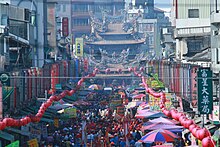Thành viên:Chỉ Có Ở Việt Nam/Triều Thiên Cung
| Bắc Cảng Triều Thiên Cung | |||||||||||
 Hình ảnh khu vực Triều Thiên Cung during the week-long birthday celebrations for Mazu năm 2009. | |||||||||||
| Phồn thể | 朝天宮 | ||||||||||
|---|---|---|---|---|---|---|---|---|---|---|---|
| Nghĩa đen | Cung điện hướng lên Thiên đình (Facing-Heaven Palace) | ||||||||||
| |||||||||||
Triều Thiên Cung ở Bắc Cảng hay đơn giản gọi là Triều Thiên Cung, tên chính thức là Bắc Cảng Triều Thiên Cung,[1] is a temple to the Chinese Goddess Mazu in Beigang Township, huyện Vân Lâm, Đài Loan.[2] Được xây dựng từ năm 1700, nơi đây trở thành một trong những địa điểm quan trọng nhất thờ Ma Tổ hay bà Thiên Hậu tại Đài Loan and is known for its extravagant temple architecture. It is visited by more than a million pilgrims every year.
Mazuism
sửaMazu, the deified form of the medieval Lin Moniang from Fujian, has an enthusiastic following on Taiwan. Beigang was one of the most important Taiwanese ports in the 17th century. As Beigang and its economy grew, at the same time the temple grew and expanded. Today the Chaotian Temple at Beigang is an important religious site and pilgrimage destination. Beigang's Mazu tours to other Mazu temples through whole Taiwan every year for visits and inspections.
Lịch sử
sửaIn 1694, a Buddhist monk named Shubi requested that a statue of Mazu be brought to Beigang from the Chaotian Temple in her hometown of Meizhou in Fujian. In 1700, Chen Li-Shum donated a building lot and raised the funds to erect Beigang's own Chaotian Temple.[1] In 1730, the temple was further expanded. In 1770, Penkang Magistrate Hsueh Chao-heng considered that the temple too simple to live up to the dignity of Goddess Matsu.[cần dẫn nguồn] Three years later another reconstruction of the temple started. In 1854 a number of ranking officials initiated a third project, expanding the temple into a palace-type architectural complex. The front wing consisted of worship courtyard and east and west chambers. The second wing was for worship of the Heavenly Mother, third wing for Goddess of mercy; east wing for San-Kuan Heavenly Emperors, west wing for Wenchang God, the 4th wing for Goddess Matsu's parents; east wing for Goddess of Childgiving and west wing, Lang God. Several renovation followed in the 20th century.
Beigang Wind Orchestra
sửaThe Beigang Wind Orchestra was founded in 1928 by Chen Chia-Hu (陳家湖).[cần dẫn nguồn] On spiritual days the orchestra marches for the Chaotian temple.
Hoạt động văn hóa
sửaThe Chaotian Temple also owns a cultural hall, where concert, dances and other activities take place.[3] On top of the building is a statue of Mazu. The Chaotian Temple also sponsors events like the Beigang International Music Festival. Since 2020 and the beginning of the COVID-19 pandemic, a Buddhist Liberation Rite of Water and Land is sponsored by Chaotian Temple to pray for the eradication of the virus.
Xem thêm
sửa- Qianliyan & Shunfeng'er
- Danh sách đền miếu thờ Ma Tổ trên khắp thế giới
- Baishatun Mazu Pilgrimage
- Gongfan Temple
- Xiluo Guangfu Temple
- Gongtian Temple, huyện Miêu Lật
- Nanyao Temple, huyện Chương Hóa
- Bengang Tianhou Temple, huyện Gia Nghĩa
- Triều Thiên Cung ở quận Tần Hoài, Nam Kinh
- Danh sách đền miếu thờ cúng tại Đài Loan
- Religion in Taiwan
Tham khảo
sửa- ^ a b “History & Development”, Official site, Beigang: Chao-Tian Temple, truy cập ngày 21 tháng 11 năm 2016. (tiếng Trung Quốc) & (tiếng Anh)
- ^ “Beigang Chaotian Temple”. The Heart of Asia. Taiwan. Truy cập ngày 8 tháng 3 năm 2014.
- ^ “Steeped in significance”. chinadailyhk. Truy cập ngày 25 tháng 9 năm 2023.
Đọc thêm
sửa- Hsu, David (27 tháng 3 năm 2008). “Beigang's two momentums — Lively traditions and religion”. The China Post. Truy cập ngày 8 tháng 3 năm 2014.
- National Geographic Traveler Taiwan. ISBN 0-7922-6555-6.
Liên kết ngoài
sửa| Wikimedia Commons có thêm hình ảnh và phương tiện truyền tải về Triều Thiên Cung. |